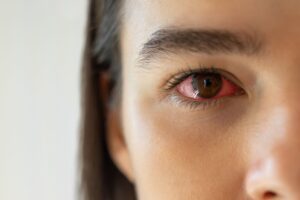When it comes to skincare, we all want to look our best and maintain healthy, radiant skin. One essential component of any skincare routine is an eye cream.
Eye creams can help reduce the appearance of fine lines, puffiness, and dark circles around the eyes. However, not all eye creams work well for everyone, and in some cases, they can cause skin reactions.
If you’ve experienced a reaction to your eye cream, don’t worry – we’ve got you covered. In this comprehensive guide, we will explore how to treat reaction to eye cream, so you can continue your journey to beautiful skin with confidence.
Understanding Eye Cream Reactions
Before we dive into the solutions, it’s crucial to understand what might be causing your skin’s adverse reaction to the eye cream. Some common reasons for these reactions include:
Ingredients that Don’t Agree
Eye creams can contain various active ingredients, and not all of them are suitable for every skin type. Some ingredients may be too harsh for sensitive skin, while others may trigger allergies. It’s essential to know what’s in your eye cream and whether any specific ingredient is causing the reaction.
Incorrect Application
Applying eye cream too close to the eye or using too much product can lead to irritation. Proper application is key, and we’ll discuss the right way to apply eye cream later in this guide.
Cross-Product Compatibility
Sometimes, using multiple skincare products from different brands can lead to compatibility issues. The interaction between different formulations may result in a reaction.
Outdated or Contaminated Product
Using an expired or contaminated eye cream can also cause skin reactions. Always check the expiry date and the condition of the product before use.
Now that we’ve covered the reasons behind eye cream reactions, let’s move on to how to treat and prevent them.
How to Treat Reaction to Eye Cream
Discontinue Use Immediately
If you notice any redness, itching, swelling, or discomfort after applying your eye cream, stop using it immediately. Continuing to use the product could worsen the reaction.
Gently Cleanse the Area
To remove the eye cream and any potential irritants, gently cleanse the affected area with a mild, fragrance-free cleanser. Avoid using harsh scrubs or abrasive materials.
Apply a Cold Compress
A cold compress can help reduce swelling and soothe irritated skin. Place a clean, soft cloth soaked in cold water over your closed eyelids for a few minutes.
Hydrate with Aloe Vera or Cucumber
Aloe vera and cucumber are known for their soothing properties. Apply a small amount of aloe vera gel or cucumber slices to the affected area to calm the skin.
Use an Over-the-Counter Antihistamine
If the reaction involves itching, an over-the-counter antihistamine can provide relief. Follow the recommended dosage on the packaging.
Consult a Dermatologist
If the reaction persists or worsens, it’s essential to consult a dermatologist. They can determine the exact cause of the reaction and recommend suitable treatments.
Patch Testing for Future Products
To avoid future reactions, always patch test new skincare products. Apply a small amount of the product behind your ear or on your wrist and wait for 24 hours to see if any adverse reactions occur.
Preventing Eye Cream Reactions
Read Ingredient Lists Carefully
Before purchasing an eye cream, read the ingredient list. Look for products that are fragrance-free and formulated for sensitive skin if you have skin sensitivities.
Perform a Patch Test
As mentioned earlier, always perform a patch test with a small amount of the product before applying it to your face. This simple step can prevent severe reactions.
Proper Application Technique
When applying eye cream, use your ring finger, as it applies the least pressure. Gently tap or pat the cream around your eye area, avoiding direct contact with the eyes.
Avoid Overusing the Product
Using too much eye cream can lead to irritation. A little goes a long way, so use a small amount as directed on the packaging.
Use Compatible Products
If you use multiple skincare products, make sure they are compatible with each other. Mixing certain ingredients can lead to adverse reactions.
How to Treat an Allergic Reaction to Skincare Product
Before we discuss treatment, it’s crucial to identify the signs of an allergic reaction. Eye cream allergies and allergic reactions to skincare products can manifest in various ways, including:
Redness: Skin may become red and inflamed, sometimes with a rash or hives.
Itching: Intense itching or a burning sensation on the affected area.
Swelling: Skin can swell, especially around the eyes, lips, or face.
Blisters: The formation of blisters or pustules.
Dryness or Peeling: Skin may become excessively dry or start to peel.
Stinging or Burning: A strong stinging or burning sensation on the skin.
Hypersensitivity: Increased sensitivity to touch or temperature changes.
How to Treat an Allergic Reaction to Skincare Products
To treat eye cream allergies and allergic reactions:
The first and most crucial step is to discontinue using the skincare product immediately. Continuing to use it may worsen the allergic reaction.
Use a mild, fragrance-free cleanser to gently cleanse the affected area. Avoid hot water, as it can further irritate the skin. Pat the skin dry with a soft, clean towel.
A cold compress can help reduce swelling and alleviate discomfort. Place a clean, soft cloth soaked in cold water over the affected area for 10-15 minutes. Do not use ice directly on the skin.
Over-the-counter antihistamines can provide relief from itching and redness. Follow the recommended dosage on the packaging, and consult a healthcare professional if you have any concerns.
Apply a hypoallergenic, fragrance-free moisturizer to the affected area to help soothe and hydrate the skin. Look for products with simple ingredients.
How to Treat Reaction to Eye Cream: Eye Cream Allergies
Prevention is the best course of action when it comes to eye cream allergies:
Patch Test: Before using a new eye cream, perform a patch test on a small area of your skin, like your inner forearm. Wait for 24-48 hours to see if any reaction occurs.
Read Ingredient Labels: Carefully read ingredient labels and avoid products with known allergens.
Fragrance-Free Products: Consider using fragrance-free eye creams, as fragrances are common allergens.
Minimalist Skincare Routine: Limit the number of products you use on your skin. A minimalist approach to skincare can reduce the chances of an adverse reaction.
An allergic reaction to eye cream can be uncomfortable, but by taking the right steps and practicing prevention, you can manage and minimize the risk of experiencing such reactions. Always prioritize your skin’s health and well-being, and choose your skincare products wisely. Your beautiful eyes deserve the best care.
Frequently Asked Questions on How to Treat Reaction to Eye Cream
Q: Can I continue using my regular skincare products if I’ve had an eye cream reaction?
A: It’s best to avoid using any potentially irritating products until the reaction has cleared. Stick to gentle, hydrating skincare during this time.
Q: How long does it take for a reaction to eye cream to subside?
A: The time it takes for a reaction to clear up varies from person to person. It can be a few days to a couple of weeks. If it persists, consult a dermatologist.
Q: Are natural or organic eye creams less likely to cause reactions?
A: Not necessarily. Natural ingredients can also cause reactions in some individuals. It’s essential to check the ingredient list and perform a patch test.
Q: Can I apply makeup over irritated skin after an eye cream reaction?
A: It’s best to avoid makeup until the reaction has subsided. Makeup can further irritate the skin.
Q: Is it safe to use over-the-counter hydrocortisone cream for eye cream reactions?
A: It’s best to consult a dermatologist before using any over-the-counter products, including hydrocortisone cream, near the eye area.
Conclusion
By understanding how to treat reaction to eye cream, you are taking the first step to becoming better.
Experiencing a reaction to your eye cream can be frustrating, but with the right steps, you can treat and prevent these issues. Always prioritize understanding the ingredients in your skincare products, proper application techniques, and patch testing.
If a reaction persists or worsens, seek professional guidance from a dermatologist. Remember, beautiful, healthy skin is achievable with the right approach to skincare. Treat your skin with care, and it will thank you with a radiant, youthful glow.


